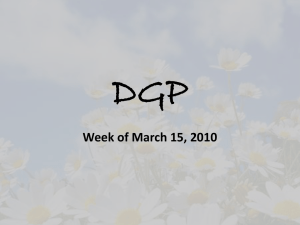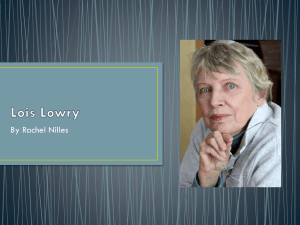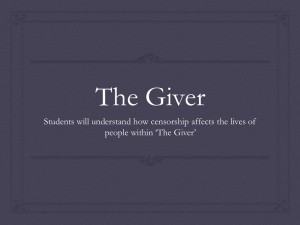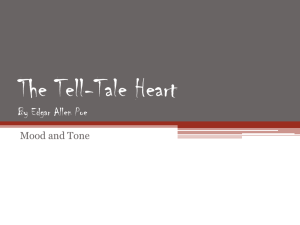The Giver In-Class PPT
advertisement
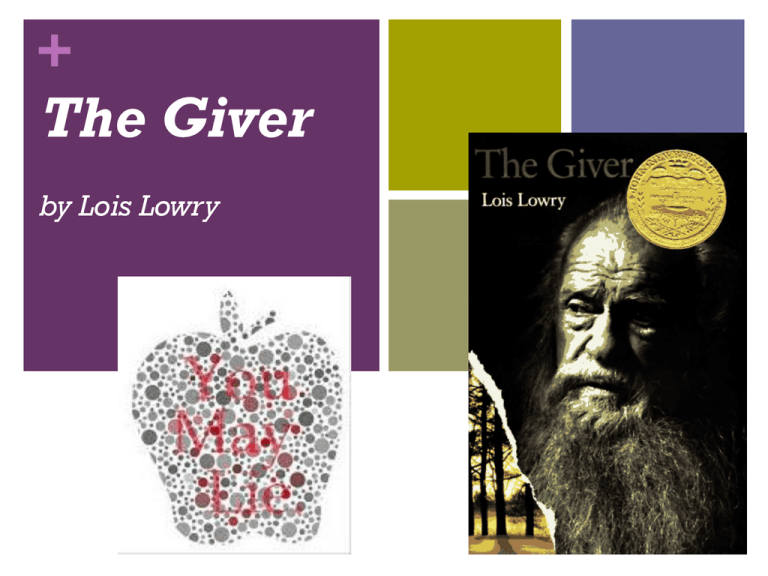
+ The Giver by Lois Lowry + Create your Reading Response Journal Table of Contents TABLE OF CONTENTS Part 1: Key Vocabulary (10 pages) Part 2: Reading Check and Interpretive Questions (15 pages) Part 3: Personal Response Questions (5 pages) Part 4: Literary Devices and Quick-writes (5 pages) Part 5: Handouts + The Giver Vocabulary Words For each section, complete the following assignments for vocabulary: As you read, highlight the vocabulary words in your text (or use post-its). Record the vocabulary in your Reading Journal Cornell notes style with the appropriate heading. Include the page number where you found the word. Guess what you think the word means using context clues from the book. Record the definition that the teacher gives you. + The Giver Reading Check & Interpretive Questions Glue these papers into your journal. Directions: For each section, answer the following questions in complete and detailed sentences in your reading journal. Skip lines between questions. Remember to re-phrase the question in your answer. Use capitals and periods. Use examples from the story to support your answer when necessary. + Personal Response Questions Directions: For each section, choose one question to answer in paragraph form in your Reading Journal. Remember to rewrite the question as your topic sentence. Your paragraph should be 5 - 8 detailed and complete sentences. Remember to use capitals and periods. Include the following heading, “Personal Response, Section ___” on the top of your paper. Warm Up Quickwrite: Answer in your notebook (PART 4). Write in complete sentences. Don’t forget your topic sentence! What would it take to make your world perfect? What would you be willing to give up to have your world perfect? + Anticipation Guide for The Giver by Lois Lowry If you agree with the statement, please stand. 1. An ideal community would not have any hunger or starvation. 2. An ideal community would not have any jealousy or competition. 3. An ideal community would not have any unemployment. 4. All children should have equal possessions and privileges at a certain age, regardless of the status of their families. 5. Families are much closer when they share their feelings. con’t next slide + 6. Life would be better and easier if we did not carry bad memories in our heads. 7. Overpopulation is such a problem that families should not be allowed to have more than two children. 8. There is no real need to learn about world history. 9. There is no real need to learn about one’s own family history. 10. One’s job or occupation in life should be a careful match to one’s interests, talents, and skills. + Meet the Author Lois Lowry was born on March 20, 1937 in Honolulu, Hawaii, to Katharine, a teacher, and Robert Hammersberg, an army dentist stationed near Pearl Harbor. Lois, her siblings, and her mother moved to Pennsylvania before the Pearl Harbor bombings in 1941. By her own account, Lowry's childhood was safe, happy, and predictable. Her father was deployed for several years, so Lowry grew up largely without his presence. L o i s L o w r y Lowry learned to read at an early age, and she loved to create stories in her mind as a child. She graduated from high school at sixteen and matriculated at Pembroke College, a women’s college that was connected to and later became part of Brown University. She studied writing with the hope of becoming a novelist. However, like many of her female peers in the 1950s, Lowry married before completing college and turned her attention to being a homemaker. She married naval officer Donald Grey Lowry in 1956 and spent the next several years raising their four children: Alix, Grey, Kristin, and Benjamin. Donald pursued his law degree at Harvard, while Lois stayed at home with the children until they reached adulthood. Eventually, she returned to school to complete her degree at the University of Southern Maine in 1972. She continued on to attend graduate school at USM. Lowry received the Newbery Medal for Children's Literature twice in her career. She earned the first one in 1990 for Number the Stars. She received her second Newbery Medal in 1993 for The Giver. Lois Lowry published more several novels during the 2000s, including Gathering Blue and Messenger, both of which are set in the same environment as The Giver. One of America's most celebrated young adult novelists, Lois Lowry has engaged millions of readers with her careful and sensitive stories dealing with major issues like death, cancer, and the Holocaust. She remains an active writer. + About the Novel The Giver was inspired in part by Lowry’s relationship with her father who was, at that time, in a nursing home having lost most of his longterm memory. She realized one day while visiting her father that, without memory, there is no pain, and began to imagine a society in which the past was deliberately forgotten. The flaws in that supposedly ideal society show the need for personal and societal memory and for making connections with the past and with each other. + Create a T-chart to record your notes on each type of society Details about UTOPIAN SOCIETY DETAILS ABOUT DYSTOPIAN SOCIETY + Welcome to UTOPIA Utopia is a perfect place where people can lead perfect lives. The Giver takes place in such an ideal community. + + + + + + + Euphemism (Create a page for this term in your journal) A euphemism is a word or term that has mild or vague connotations and that serve to mask the offensiveness or harshness of the actual word or term. What euphemisms are used in our society? Example: A used car being called “certified preowned” Think of two other examples of your own. + Denotations and Connotations (make a page in your journal with this title) The connotations of a word are the suggestions and associations that go along with the word, stretchingbeyond its dictionary meaning. Notice the first sentence of the novel. “It was almost December and Jonas was beginning to be frightened.” The word December is rich in connotations: cold, darkness, the death that comes to plants in winter.The opposite of connotation is DENOTATION, or the dictionary definition of a word. Every word has both a denotation and a connotation. + Tone and Mood (Make a page in your journal with this title) Tone is the author’s attitude toward the writing (his characters, the situation) and the readers. A work of writing can have more than one tone. An example of tone could be both serious and humorous. Tone is set by the setting, choice of vocabulary and other details. Mood is the general atmosphere created by the author’s words. It is the feeling the reader gets from reading those words. It may be the same, or it may change from situation to situation. + Words that describe Mood Fanciful Melancholy Frightening Mysterious Sentimental Happy Sorrowful Joyful Frustrating Suspenseful Romantic Gloomy + Let’s read the first nine paragraphs of chapter one of The Giver. Pay attention to the author’s tone and the mood of the writing. After reading: What is the hook the author uses to get your interest? What How is the author’s tone? does the story make you feel? (mood)



